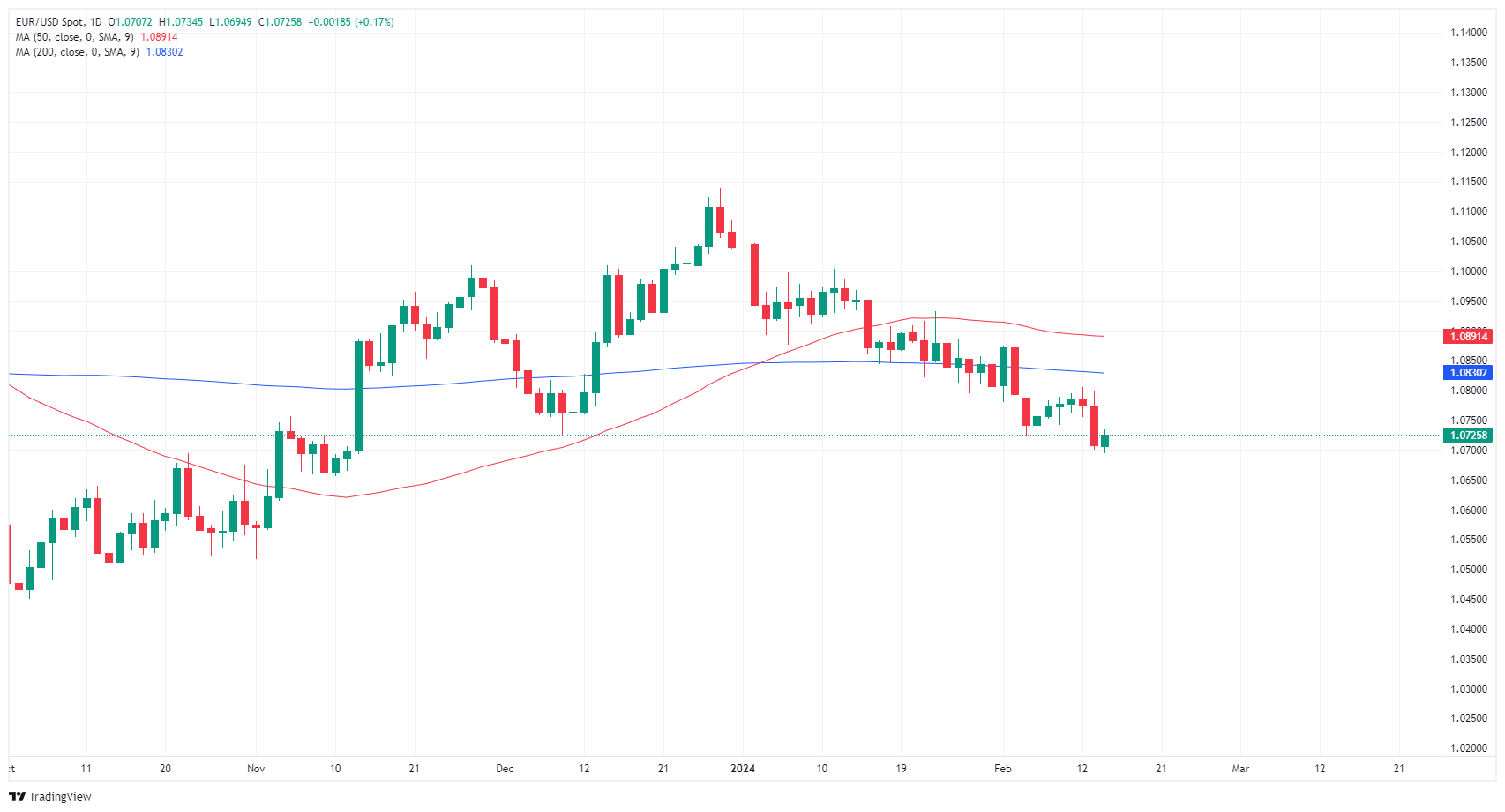EUR/USD pares losses on quiet Wednesday after European GDP holds steady

- EUR/USD recovers from dip into 1.0700, but bullish momentum remains thin.
- Pan-European GDP figures met already-low expectations.
- An appearance from ECB President Lagarde and US Retail Sales in the pipe.
EUR/USD found thin footing to stage a rebound from a decline into 1.0700, but the high side is looking far away as the pair remains challenged by bearish flows as the US Dollar (USD) finds broad-market support after US inflation figures on Wednesday spooked market sentiment.
European Gross Domestic Product (GDP) figures met expectations, but a lopsided pan-European economy suffering from lagging growth saw the bar set very close to the floor with investors forecasting a flat growth print.
Daily digest market movers: EUR/USD rebounds from 1.0700, but bearish sentiment weighs heavy
- European GDP printed at 0.0% for the fourth quarter, as expected.
- Annualized quarterly euro area GDP showed slim 0.1% growth for the year through the fourth quarter.
- European Industrial Production showed a healthy uptick to 2.6% in December, well above the forecast -0.2% versus the previous month’s 0.4% (revised from -0.3%).
- Euro (EUR) traders will be keeping an eye out for European Central Bank (ECB) President Christine Lagarde’s appearance slated for early Thursday.
- ECB President Lagarde will be testifying before the European Parliament’s Committee on Economic and Monetary Affairs in Brussels at 08:00 am GMT Thursday.
- US Retail Sales figures are also due Thursday.
- US Retail Sales in January are expected to decline in January, coming in at -0.1% versus the previous month’s 0.6%.
Euro price today
The table below shows the percentage change of Euro (EUR) against listed major currencies today. Euro was the strongest against the Pound Sterling.
| USD | EUR | GBP | CAD | AUD | JPY | NZD | CHF | |
| USD | -0.17% | 0.23% | -0.17% | -0.62% | -0.11% | -0.50% | -0.22% | |
| EUR | 0.18% | 0.40% | 0.01% | -0.44% | 0.04% | -0.31% | -0.02% | |
| GBP | -0.23% | -0.41% | -0.39% | -0.84% | -0.34% | -0.73% | -0.44% | |
| CAD | 0.17% | -0.01% | 0.39% | -0.44% | 0.05% | -0.33% | -0.05% | |
| AUD | 0.60% | 0.44% | 0.83% | 0.44% | 0.48% | 0.12% | 0.39% | |
| JPY | 0.12% | -0.07% | 0.33% | -0.04% | -0.51% | -0.39% | -0.10% | |
| NZD | 0.50% | 0.32% | 0.72% | 0.33% | -0.11% | 0.31% | 0.28% | |
| CHF | 0.20% | 0.03% | 0.43% | 0.06% | -0.40% | 0.09% | -0.29% |
The heat map shows percentage changes of major currencies against each other. The base currency is picked from the left column, while the quote currency is picked from the top row. For example, if you pick the Euro from the left column and move along the horizontal line to the Japanese Yen, the percentage change displayed in the box will represent EUR (base)/JPY (quote).
Technical analysis: EUR/USD recovers to 1.0730 region, further topside limited by technical ceiling
EUR/USD sagged into 1.0700 early Wednesday following Tuesday’s US inflation-fueled tumble, and a near-term recovery sees the pair hampered on the bearish side of the 200-hour Simple Moving Average (SMA) near 1.0760.
EUR/USD is on pace for a fourth straight week of decline, and a bearish Friday close will have the pair close lower for five of the last six consecutive trading weeks. The pair is down around 3.7% from December’s peak bids near 1.1140, and bearish momentum continues to drag the pair further down from the 200-day SMA near 1.0830.
EUR/USD hourly chart
EUR/USD daily chart
ECB FAQs
The European Central Bank (ECB) in Frankfurt, Germany, is the reserve bank for the Eurozone. The ECB sets interest rates and manages monetary policy for the region.
The ECB primary mandate is to maintain price stability, which means keeping inflation at around 2%. Its primary tool for achieving this is by raising or lowering interest rates. Relatively high interest rates will usually result in a stronger Euro and vice versa.
The ECB Governing Council makes monetary policy decisions at meetings held eight times a year. Decisions are made by heads of the Eurozone national banks and six permanent members, including the President of the ECB, Christine Lagarde.
In extreme situations, the European Central Bank can enact a policy tool called Quantitative Easing. QE is the process by which the ECB prints Euros and uses them to buy assets – usually government or corporate bonds – from banks and other financial institutions. QE usually results in a weaker Euro.
QE is a last resort when simply lowering interest rates is unlikely to achieve the objective of price stability. The ECB used it during the Great Financial Crisis in 2009-11, in 2015 when inflation remained stubbornly low, as well as during the covid pandemic.
Quantitative tightening (QT) is the reverse of QE. It is undertaken after QE when an economic recovery is underway and inflation starts rising. Whilst in QE the European Central Bank (ECB) purchases government and corporate bonds from financial institutions to provide them with liquidity, in QT the ECB stops buying more bonds, and stops reinvesting the principal maturing on the bonds it already holds. It is usually positive (or bullish) for the Euro.
